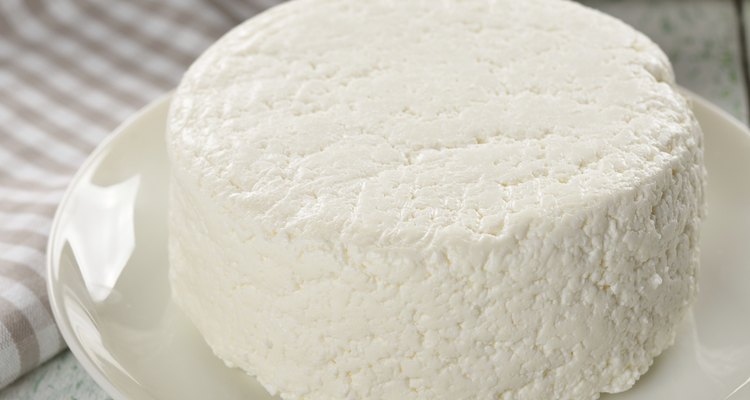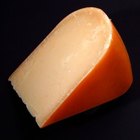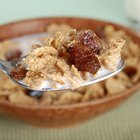
olvas/iStock/Getty Images
Cottage cheese is a mild-tasting, high-protein cheese curd product. Made by curdling milk and draining most of the whey, or liquid, from the solid product, cottage cheese is essentially unprocessed or raw cheese. Due to its long history and adaptability, cottage cheese is linked to a number of interesting facts.
Cottage Cheese Transformations
Cottage cheese begins as slightly soured, low-fat pasteurized milk. This creates a substance with both liquid, or whey, and solid, or curd, parts. By draining the whey from the curds, you create cottage cheese. Slightly pressing or draining this gelatinous substance further creates pot cheese. As this dry-yet-creamy cheese retains some moisture, you can press pot cheese further to create farmer's cheese, a solid and crumbly cheese. While farmer's cheese is generally made with milk, cream and salt, the drier, less flavorful hoop cheese is made in a similar fashion without the cream and salt.
Cottage Cheese in History
While the history of cottage cheese dates back to the ancient Greeks and Egyptians, its name is derived from the time of the early American settlers. As this cheese was made on their stovetops and in their kitchens, the name cottage cheese arose to reflect the small dwellings that served as the settlers' homes. With such roots in American history, it may come as no surprise that it was a staple food for President Richard Nixon. Usually eaten for lunch, Nixon's last meal as president was a bowl of cottage cheese with a slice of pineapple on it.
Nutritional Facts
Compared with other cheeses, cottage cheese is surprisingly healthy. A 100-g serving of creamed cottage cheese contains 98 calories and only 4.3 g of fat, 1.7 of which is saturated. The same serving size contains 3.4 g of carbohydrates and 364 mg of sodium, or 16 percent of your recommended daily intake based on a 2,000-calorie per day diet. Though popular among athletes and bodybuilders due to its low-fat, low-calorie and low-carbohydrate content, cottage cheese is primarily known for its protein, with 11.1 g of protein in a 100-g serving.
Production and Storage
According to a 2010 USDA report, Americans consume approximately 600 million lbs. of cottage cheese each year. With 100 lbs. of milk required to produce 15 lbs. of cottage cheese, this means that approximately 4 billion lbs. of milk are required to produce enough cottage cheese to satisfy the U.S. market.
Based on the USDA's numbers, the average American eats approximately 2 pounds of cottage cheese every year. However, due to cottage cheese's short shelf life, these numbers may be distorted by the amount that is discarded every year. To extend the life of your cottage cheese, ensure that it is always kept in your fridge in a sealed container. Once cottage cheese approaches its expiry date, you may want to try pressing it to make one of the harder, longer-lasting cheeses listed above.
Related Articles

Cheeses Similar to Feta

Difference Between Fermented Milk & ...

What Types of Cheeses Are Unpasteurized?

What Good Bacteria Is in Cheese?

How to Make Muenster Cheese

Facts About Gouda Cheese

How to Read a Tag Heuer Model Number

What Is a Black Forest Ham?

Different Types of Flannel Fabrics

What Is Animal Rennet?

What Happens to Cream Cheese if It's ...

What Is Vegetable Ghee?

What Is an Anniversary Clock?

Why Does Greek Yogurt Have More Protein ...

What Is Triple-Milled Soap?
Clotted Cream Vs. Double Cream

How Long Will Sour Cream Keep?

Can You Drink Milk That Expires the ...

Calories in a Bowl of Raisin Bran Cereal

Aged Cheeses That Do Not Melt
References
- Trivia Library: History of Dairy Products: Cottage Cheese
- Online Etymology Dictionary: Cottage
- USDA Nutrient Database: Cheese, Cottage, Creamed, Large or Small Curd
- University of Kentucky College of Agriculture: Making Cottage Cheese at Home
- "United States Department of Agriculture: A Report from the Economic Research Service"; Long-Term Growth in U.S. Cheese Consumption May Slow; Christopher G. Davis et al.; August 2010
Resources
Writer Bio
Matthew Lee has been writing professionally since 2007. Past and current research projects have explored the effect of a diagnosis of breast cancer on lifestyle and mental health and adherence to lifestyle-based (i.e. nutrition and exercise) and drug therapy treatment programs. He holds a Master of Arts in psychology from Carleton University and is working toward his doctorate in health psychology.
Photo Credits
olvas/iStock/Getty Images